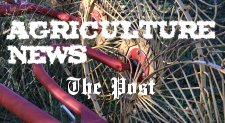Moles? Voles? What’s That Hole in My Yard?
 The past couple of weeks have been fairly pleasant. Granted we have had some rain this year…a lot of rain, but I will take it. With the warmer temperatures many of us have been outside more and have been getting our yards and landscapes ready for the upcoming growing season. While in the yard several homeowners have noticed something out of the ordinary, holes in their yard. I have received numerous calls the last two weeks from homeowners seeking advice to rid their yards of these critters and have made several visits with homeowners experiencing damage. No matter which property I visit or how extensive the damage is, the question is always: how do I fix it? This is not an easy question to answer. When dealing with wildlife, there is a rarely magical bullet. As with any problem, the first step is to identify what animal is actually causing the damage. Is it a mole? Is it a vole? While these creatures share a similar name, they are different and each requires a different approach to control the damage they have caused.
The past couple of weeks have been fairly pleasant. Granted we have had some rain this year…a lot of rain, but I will take it. With the warmer temperatures many of us have been outside more and have been getting our yards and landscapes ready for the upcoming growing season. While in the yard several homeowners have noticed something out of the ordinary, holes in their yard. I have received numerous calls the last two weeks from homeowners seeking advice to rid their yards of these critters and have made several visits with homeowners experiencing damage. No matter which property I visit or how extensive the damage is, the question is always: how do I fix it? This is not an easy question to answer. When dealing with wildlife, there is a rarely magical bullet. As with any problem, the first step is to identify what animal is actually causing the damage. Is it a mole? Is it a vole? While these creatures share a similar name, they are different and each requires a different approach to control the damage they have caused.
Mole activity can be identified by the raised tunnels they create under the soil through the yard. Moles burrow through the soil looking for food such as grubs, insects, and earthworms. They are fairly solitary and are not a social animal. The mole has fairly few predators due to the fact that they spend their time underground, protecting them from would be predators including dogs and coyotes. Moles are typically around seven inches long and weigh around a quarter pound. So the question remains, I’ve got moles, now what? Typically the best method of eliminating a mole problem is through a comprehensive approach which includes more than one management tool. There are many commercial products available for homeowners to purchase which can aid in the removal of moles. The first step is often finding out where the mole is. Take some time one evening and walk over the tunnels collapsing them. Not all tunnels are used frequently and some will never be used again, but the active tunnels will be reopened within the next day or so. This information can be valuable when placing traps. After one has determined where the moles are active, it is time to begin our efforts in controlling the problem. One of the most effective methods is a harpoon-type trap. This trap straddles the tunnel and when tripped sends a harpoon into the soil when tripped by the mole underneath. Baits and pesticides are also available for purchase by the homeowner and can be effective, but use the mole’s diet in aiding your decision on what to use. Moles like grubs and earthworms, so plant based baits and pesticides might not be the best choice. Repellants are also available. Personally, these are one of my least favorite options. They can work, but might push the moles in my yard to my neighbors. More than likely any method will take some time, persistence, and experimentation, but can be effective. After ridding the property of the mole, it might be a safe practice to treat the yard for insects and grubs hopefully deterring any future moles from finding a new lush feeding ground. Several schools of thought exist when dealing with the timing of pesticide application for grubs and yard insects, but essentially the only way to make it effective is to…do it. It can be argued that treating for grubs before and while trapping the moles is a good practice, and quite frankly it’s hard to argue the logic if the end result is to rid our yard of a mole. One precautionary statement on this method: if one was to remove the moles feed source before getting rid of the mole this can lead to increased damage to the yard as the mole explores more territory looking for food.
Voles are another common culprit for holes in the yard. They can be present in the yard, near and in landscapes, and around fruit trees. The vole will make a meal out of plant materials, root systems, and flower bulbs. They create a small hole (silver dollar size or smaller) which has no dirt pushed up to the surface. It is unlike the mole and does not produce tunnels under the soils surface, but instead creates trails through the yard underneath the protection of grass and other landscaping. These trails are much like the vole’s highway system and can be a great place to intercept the vole with traps and pesticides. Commercial products are available to the homeowner to aid in the removal of voles. Commercial pesticides carrying the label for use on voles and multi-use traps are both effective means for control. As when using any pesticide, use caution and be mindful of other animals and distribute baits only in locations accessible to the target species. Enclosed bait stations work well. Snap traps can be used, but are labor intensive possibly making the multi catch trap a better solution. Voles will more than likely be present in higher numbers than the mole so persistence will be key to correcting the problem. Voles are also a problem around fruit trees and in orchards. This problem can be combated several ways and include using wire mesh around the fruit trees to create a barrier and either removing all grass at the base of the trees or cut the grass short which takes the protective covering of the grass away from the vole.
As with all problems, correct identification of the cause is essential to solving the problem and will prevent wasting time trying ineffective controls. There are several great resources available to homeowners from many of the extension organizations across the US. One of the best resources I have found is the Internet Center for Wildlife Management (icwdm.org). This website includes information from a large number of universities and has a large selection of publications. Also, on the website you will find aids in not only identifying holes in the ground, but also control methods and some great how to videos. Another great source for information is the eXtension.org website. This website is a collaborative effort amongst all extension services throughout the country and includes information on a wide array of topics. Simply type in a search topic and the results will appear. The website also gives visitors the opportunity to send a question via the web which will be directed to an extension agent that has experience with your specific topic.
For more information, please feel free to contact me at UT Jefferson County Extension 865-397-2969/3969 or at Ahopkin1@utk.edu. Programs in agriculture and natural resources, 4-H youth development, family and consumer sciences, and rural development. University of Tennessee Institute of Agriculture, U.S. Department of Agriculture and county governments cooperating. UT Extension provides equal opportunities in programs and employment.












